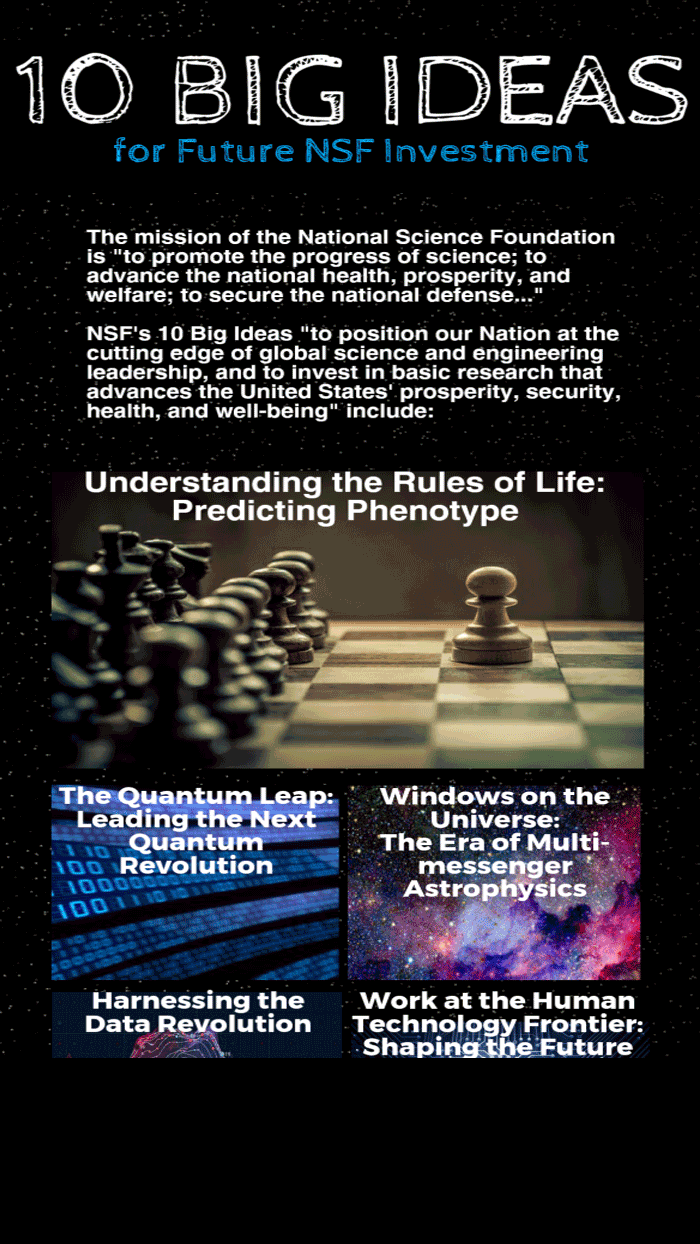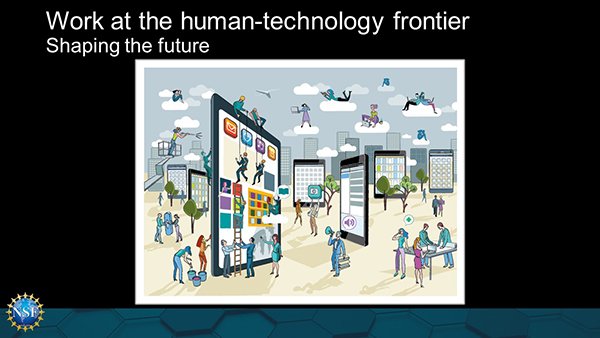10 Big Ideas for Future NSF Investments

In the nearly seven decades since it was founded, the National Science Foundation (NSF) has played a critical role in establishing U.S. leadership in science and engineering (S&E), creating innovations that drive the nation's economy and educating the next generation of scientists and engineers.
As we look ahead to the coming decades, we must envision bold questions that will drive NSF's long-term research agenda -- questions that will ensure future generations continue to reap the benefits of fundamental S&E research.
This is the reason behind these 10 "big ideas." They capitalize on what NSF does best: catalyze interest and investment in fundamental research, which is the basis for discovery, invention and innovation. They are meant to define a set of cutting-edge research agendas and processes that are uniquely suited for NSF’s broad portfolio of investments, and will require collaborations with industry, private foundations, other agencies, science academies and societies, and universities.
Funding these ideas will push forward the frontiers of U.S. research and provide innovative approaches to solve some of the most pressing problems the world faces, as well as lead to discoveries not yet known.
The National Science Foundation’s (NSF) INCLUDES (Inclusion across the Nation of Communities of Learners of Underrepresented Discoverers in Engineering and Science) program aims to transform science, technology, engineering and mathematics (STEM) education and career pathways at the national scale, making them more fully and widely inclusive. Over the next decade, the program seeks to expand the composition of the S&E workforce so that it better reflects the diversity of U.S. society.
The U.S. is experiencing a period of significant demographic shifts; the Census Bureau projects that by 2050, minorities will comprise 53 percent of the population. In contrast, approximately 30 percent of people now working in S&E are minorities. To maintain U.S. leadership in science, the nation must address the challenge of broadening participation in STEM within a single generation.

In Fiscal Year 2016, NSF launched INCLUDES, a bold initiative. NSF INCLUDES will invest in alliances and partnerships, employing the concept of collective impact by uniting a wide variety of collaborators to solve a common problem. It will develop scalable ways to broaden STEM potential among traditionally underrepresented groups -- including women,
Hispanics, African Americans, Native Americans, persons with disabilities, people from rural areas and people of low socioeconomic status.
Multi-year NSF INCLUDES alliances will engage partners from private and corporate philanthropy, federal agencies and scientific professional societies. The program’s structure will provide a networked testbed for research on STEM inclusion. This will enable participants to determine the key components and approaches that lead to progress in STEM inclusion, as well as the elements that allow successful local alliances to be scaled up for broader use.

Developments from NSF INCLUDES will inform other possible ways through which NSF programs can integrate an inclusion and diversity mindset. Long-term program development occurs throughout the National Science Foundation (NSF), usually in individual directorates or divisions. Crosscutting programs are usually developed on yearly budget cycles, which may limit vision and scope. To better identify bold, long-term foundational research questions -- and set the stage for breakthrough S&E all the way to NSF’s centennial -- we propose the creation of NSF 2026: the Integrative Foundational Fund.
NSF 2026 will allow for systemic community input into long-term program development, and capture the imagination of critical stakeholders about what might be. NSF 2026 intends to transcend established scientific structures and standard operating procedures. It will ensure continuous exploration at the frontiers and risk-taking in areas that might not fit inside the “box” of any particular program. Such programs could cross boundaries in innovative ways, fill recognized gaps or take advantage of new opportunities.

Imagine researchers being able to precisely foresee future characteristics of biological organisms: human disease risk, drug therapy response, food crop yields and environmental remediation to name just a few. Nature is full of diverse species in all shapes, colors and sizes, each with characteristics resulting from a complex interaction of genetics and the environment.
The universally recognized biggest gap in biological knowledge is our inability to predict an organism’s observable characteristics -- its phenotype -- from what we know about its genetics and environment. Many factors influence the traits in an organism, making this prediction is extremely complex.
To unravel these dynamics, the National Science Foundation (NSF) proposes an initiative that will require convergence of research across biology, computer science, mathematics, behavioral sciences and engineering. This initiative, Understanding the Rules of Life: Predicting Phenotype, will include research in data integration, analysis, modeling and informatics techniques. NSF has supported fundamental work in this area including the iPlant Collaborative, an online platform of data tools for large-scale analysis of complex biological problems.
From robots on the assembly line and in the operating room to the office that travels with you 24/7, the world of work is changing. We are at the cusp on a major transformation in work that is being driven by combinations of machine learning, artificial intelligence, the internet-ofthings, and robotics.
To address the scientific and technical challenges of the future of work and productivity, the National Science Foundation (NSF) proposes a bold initiative, Work at the Human-Technology Frontier: Shaping the Future, to catalyze the interdisciplinary S&E needed to understand the benefits as well as the risks of new technologies and to enable the creation of technologies that can collaborate with humans to enrich their lives in the workplaces of the future.
This initiative will tackle pressing research challenges at the human-technology frontier about the changing ways we produce goods, provide services, and collaborate with our colleagues. A changing future work place will require a changing future work force, making education and lifelong learning important priorities. On the cusp of change, we have a unique opportunity to actively shape the development and use of technologies to improve the quality of work while also increasing productivity and economic growth in manufacturing and in service sectors suchas healthcare and education.
The National Science Foundation’s (NSF) S&E activities rely increasingly on infrastructure that is diverse in space, cost and implementation time -- everything from major observatories to nationwide sensor networks to smaller experiments.
NSF funds relatively small research infrastructure projects -- up to $20 million -- through its individual scientific directorates. Large infrastructure projects -- above $100 million – are funded through another mechanism: the Major Research Equipment and Facilities Construction (MREFC).
There are many important potential experiments and facilities that fall between these amounts; this gap results in missed opportunities that leave essential science undone. The longterm consequences of that neglect will be profound for science as well as for our nation’s economy, security and competitiveness. We need a new approach to research infrastructure, one more dynamic and flexible in response to this new reality.
One relatively simple approach is to lower the threshold for MREFC expenditures and develop an agile, yet carefully monitored, process for funding experimental research capabilities in the mid-scale range.
We have arrived at a special moment in our quest to understand the universe. For years, we have been making observations across the known electromagnetic spectrum -- from radio waves to gamma rays -- and many great discoveries have been made as a result. Now, for the first time, we are able to observe the world around us in fundamentally different ways than we previously thought possible. Using a powerful and synthetic collection of approaches, we have expanded the known spectrum of understanding and observing reality. Just as electromagnetic radiation gives one view of the universe, particles such as neutrinos and cosmic rays provide a different view. Gravitational waves give yet another.
Together, these different windows will provide unique insights into the nature and behavior of matter and energy and help to answer some of the most profound questions before humankind, such as how the universe began and why it is accelerating.
These research goals and topics are clearly at the heart of the fundamental mission of the National Science Foundation (NSF): to promote the progress of science. NSF’s longstanding investments in ground-based astronomy, particle astrophysics and gravitational physics puts it clearly in the center of the action for all of these messengers. As the one agency engaged in all three types of multi-messenger astrophysics, NSF is uniquely positioned to promote the interagency and international collaborations needed to advance understanding in this field.
The Arctic is warming at twice the rate of the rest of the Earth with far-reaching consequences for Arctic residents, particularly indigenous peoples. Arctic change will fundamentally alter climate, weather and ecosystems globally in ways that we do not yet understand but that will have profound impacts on the world’s economy and security. Rapid loss of Arctic sea ice and other changes will also bring new access to the Arctic’s natural resources such as fossil fuels, minerals, and new fisheries, and this new access is already attracting international attention from industry and nations seeking new resources.
The National Science Foundation (NSF) proposes to establish an observing network of mobile and fixed platforms and tools across the Arctic to document these rapid biological, physical, chemical and social changes, leveraging participation by other federal agencies. Current Arctic observations are sparse and inadequate for enabling discovery or simulation of the processes underlying Arctic system change or to assess their environmental and economic impacts on the broader Earth system.
Among federal agencies, NSF is unique in its ability to fund bottom-up research driven by the U.S. academic research community across the physical, biological, social, engineering and computational sciences. Arctic research also offers greater opportunity for the next generation of Arctic researchers.
NSF has long been a leader of Arctic system science and the creation of an Arctic observing network. Of all agencies involved in Arctic research, NSF supports the most capable Arctic logistics infrastructure, priming the foundation to take a key role in navigating the new Arctic.
The increasing speed at which we collect data, as well as the increasing volume and variety of that data, are profoundly transforming research in all fields of S&E. This deluge of data -- from large scientific facilities, advanced cyberinfrastructure, new data analysis tools and more -- is forcing scientists to ask and answer new types of questions.
To harness this data revolution, the National Science Foundation (NSF) proposes Harnessing Data for 21st Century Science and Engineering, a bold initiative to develop a cohesive, nationalscale approach to research data infrastructure and a 21st-century workforce capable of working effectively with data.
This initiative will support basic research in math, statistics and computer science that will enable data-driven discovery through visualization, better data mining, machine learning and more. It will support an open cyberinfrastructure for researchers and develop innovativeeducational pathways to train the next generation of data scientists.
This initiative builds on NSF’s history of data science investments. As the only federal agency supporting all fields of S&E, NSF is uniquely positioned to help ensure that our country’s future is one enriched and improved by data.
In the first half of the 20th century, physics was revolutionized when scientists began to examine and understand the behavior of matter and energy at very small -- atomic and subatomic -- scales, creating the branch called quantum physics. The world is on the threshold of the next quantum revolution and the National Science Foundation (NSF) has a leading role to play. Many of today’s technologies -- lasers, computers and LEDs among them -- rely on the interaction of matter and energy at extremely small and discrete dimensions. By exploiting interactions of these quantum systems, next-generation technologies for sensing, computing, modeling and communicating will be more accurate and efficient. To reach these capabilities, researchers need understanding of quantum mechanics to observe, manipulate and control the behavior of particles and energy at dimensions at least a million times smaller than the width of a human hair.
The Quantum Leap: Leading the Next Quantum Revolution is NSF’s approach to identifying and supporting this research. It will address fundamental questions about quantum behavior and the manipulation of quantum systems.
NSF can drive this compelling basic research and its potentially significant applications across a broad swath of S&E. NSF has invested in fundamental research related to quantum systems for decades and possesses the firm foundation needed to make this initiative a success. Research into quantum materials is essential for preparing future scientists to implement the discoveries of the next quantum revolution into technologies that will benefit the average consumer. There will be strong connections to industry, federal agencies and international partners.
The grand challenges of today -- protecting human health; understanding the food, energy, water nexus; exploring the universe at all scales -- will not be solved by one discipline alone. They require convergence: the merging of ideas, approaches and technologies from widely diverse fields of knowledge to stimulate innovation and discovery.
The National Science Foundation (NSF) is well positioned to foster convergence: We have deep connections to all fields of S&E and have been supporting interdisciplinary research for decades. Convergence blends scientific disciplines in a coordinated, reciprocal way and fosters the robust collaborations needed for successful inquiry. Convergence builds and supports creative partnerships and the creative thinking needed to address complex problems.
To build a system that truly supports convergent science, NSF would strategically invest in research projects and programs that are motivated by intellectual opportunities and important societal problems. That way, not just scientists but everyone could benefit from the convergence of the physical sciences, biological sciences, computing, engineering, and the social and behavioral sciences.